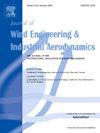Flow field simulation and protective effectiveness research on sand barriers by computational fluid dynamics (CFD)- a review
IF 4.9
2区 工程技术
Q1 ENGINEERING, CIVIL
Journal of Wind Engineering and Industrial Aerodynamics
Pub Date : 2025-02-17
DOI:10.1016/j.jweia.2025.106024
引用次数: 0
Abstract
Sand barriers are indispensable protective measures in the early stage of sand control, which could effectively increase subsurface roughness and reduce wind erosion. Advances in CFD techniques render simulation of airflow around sand barriers more efficient and intuitive, to accurately analyze airflow mechanisms and comprehensively optimize barrier design. Abundant CFD studies on sand barriers have been conducted, but a systematic review is still lacking. Based on four sets of keywords including barrier, CFD simulation, incoming flow conditions and shelter effect evaluation, we conducted a literature search on numerical simulation studies of sand barriers primarily in Web of Science core database by now, and 152 research papers were finally included. This paper presents the airflow and wind-blown sand flow structures around various types of sand barriers, systematically summarizes the impact of barrier geometrical parameters (porosity, height, shape, and arrangement) and incoming flow conditions (incoming wind speed and wind direction) on the protective effect of sand barriers, and provides a comprehensive summary of evaluation indexes on the shelter effect of sand barriers. On this basis, we discuss the irreplaceable advantage of CFD technology and the limitations of current research. Accordingly, we propose four aspects for future CFD research, including sand barrier optimization under real underlying surface conditions, simulations using realistic sand barrier models, research on flexible sand barriers, and investigations into comprehensive protective measures that integrate sand barriers. This study hopes to provide insight into CFD research and engineering application of sand barriers.

利用计算流体动力学 (CFD) 进行沙障流场模拟和防护效果研究--综述
沙障是防沙初期必不可少的防护措施,能有效提高地下粗糙度,减少风蚀。CFD技术的进步使得沙障周围气流模拟更加高效、直观,能够准确分析气流机理,全面优化沙障设计。虽然对砂障进行了大量的CFD研究,但仍缺乏系统的综述。基于屏障、CFD模拟、来流条件和遮蔽效果评价四组关键词,我们目前主要在Web of Science核心数据库中对沙障数值模拟研究进行了文献检索,最终收录了152篇研究论文。介绍了各类沙障周围的气流和风沙流结构,系统总结了沙障几何参数(孔隙度、高度、形状、排列)和来流条件(来风风速、风向)对沙障防护效果的影响,并对沙障遮挡效果的评价指标进行了综合总结。在此基础上,讨论了CFD技术不可替代的优势和目前研究的局限性。因此,我们提出了未来CFD研究的四个方面:真实下垫面条件下的沙障优化、真实沙障模型模拟、柔性沙障研究以及综合沙障防护措施研究。本研究旨在为砂障的CFD研究和工程应用提供参考。
本文章由计算机程序翻译,如有差异,请以英文原文为准。
求助全文
约1分钟内获得全文
求助全文
来源期刊
CiteScore
8.90
自引率
22.90%
发文量
306
审稿时长
4.4 months
期刊介绍:
The objective of the journal is to provide a means for the publication and interchange of information, on an international basis, on all those aspects of wind engineering that are included in the activities of the International Association for Wind Engineering http://www.iawe.org/. These are: social and economic impact of wind effects; wind characteristics and structure, local wind environments, wind loads and structural response, diffusion, pollutant dispersion and matter transport, wind effects on building heat loss and ventilation, wind effects on transport systems, aerodynamic aspects of wind energy generation, and codification of wind effects.
Papers on these subjects describing full-scale measurements, wind-tunnel simulation studies, computational or theoretical methods are published, as well as papers dealing with the development of techniques and apparatus for wind engineering experiments.

 求助内容:
求助内容: 应助结果提醒方式:
应助结果提醒方式:


